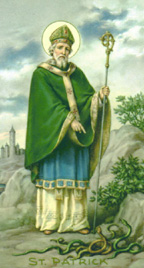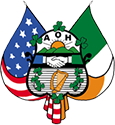St. Patrick, Bishop (c. 389-c. 461)
Patron of Ireland, Nigeria
 The son of a Roman military officer stationed in Britain, Patrick was more interested in a career than in religion. At the age of 16, however, he was captured by Irish pirates and taken to Ireland. For six years he worked as a shepherd, suffering from cold and hunger as well as the loss of his freedom. He finally turned to God, his only hope, as he looked for a way to return to Britain. Eventually, he escaped aboard a German vessel, paying his way by taking care of a pack of stolen dogs the crew planned to sell. Back at home, Patrick became a priest.
The son of a Roman military officer stationed in Britain, Patrick was more interested in a career than in religion. At the age of 16, however, he was captured by Irish pirates and taken to Ireland. For six years he worked as a shepherd, suffering from cold and hunger as well as the loss of his freedom. He finally turned to God, his only hope, as he looked for a way to return to Britain. Eventually, he escaped aboard a German vessel, paying his way by taking care of a pack of stolen dogs the crew planned to sell. Back at home, Patrick became a priest.
Return to Ireland
When the Church discussed sending missionaries to Ireland, Patrick remembered his days of slavery and struggled to decide whether or not to volunteer. Finally, when the bishop of Ireland died, Patrick asked to go. He had had a dream in which voices of Irish people called to him, “We beg you to come walk with us again.” Though Patrick was not well educated, the pope saw in him the qualities of a missionary. In addition, Patrick already knew the language of Ireland and had spent 15 years in parish ministry. At the age of 42, Patrick was ordained a bishop and was sent to northern and western ireland, where no one had ever preached the Gospel before.
A Miracle…
One of the Druids’ great feasts was the spring festival, celebrated the same night as the Easter Vigil. The day before the feast, people all over the land were ordered to put out their fires. No fire could be lit until the sacred fire blazed up on the Hill of Tara, where all the pagan leaders met to honor their gods.
Patrick had heard the order, but he knew that Jesus Christ, not the gods of the Druids, was the Light of the World. That evening, as soon as it was dark enough, and before the Druids could light their fires, Patrick and his companions began the great Easter Vigil celebration. They had gathered on the Hill of Slane, directly opposite the Hill of Tara. Patrick knew that the Druids would be angry when they saw the Easter fire. He was right! When the Druids saw the fire, they told their king, “Unless we put out that fire at once, this very night, it will blaze forever in this land.” The pagans rushed toward patrick’s Easter fire and tried to put it out and to kill Patrick. But nothing they did could extinguish the flame, and Patrick was kept from harm. He stood by the Easter fire and sang a song that has sounded from Ireland ever since: “Let God arise and let his enemies be scattered.” Christ, the Light of the World, has brightened the lives of Irish people and made their land a great nation.
5th Century Ireland
The people of Ireland lived in tribes and clans and worshiped pagan gods. Druids, who were magicians and wizards, kept the people away from any other religion. Patrick started with the most powerful clan: Tara. The chief respected Patrick and was converted. The Druids plotted to do away with Patrick, but Patrick continued to preach the faith, ready for death at any time. It is said that he used a shamrock to teach that there is only one God, but three divine Persons – Father, Son, and Holy Spirit. People remembered this mystery of faith whenever they saw a shamrock with its three leaves.
“Patrick” in the Irish language is
Padraig
(Paw-drug)
